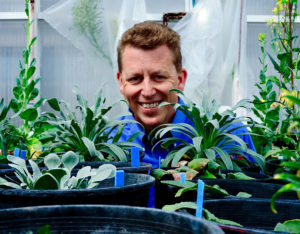 “JGI has phenomenal scientists and staff who are part of our dream team.”
“JGI has phenomenal scientists and staff who are part of our dream team.”
How long have you collaborated with the JGI?
I have been involved with the JGI Community Science Program (CSP) since 2012. I am involved in two JGI projects.
The first one is the Brassicales Map Alignment Project (BMAP), which was funded in 2012. That is a large collaborative project led by Rod Wing (click here to watch his user profile).
The second project that I am the lead PI on is entitled, “Investigating the diversity of mycorrhizal fungi to understand the evolution and function of symbiosis with orchids.” This project started in 2016 and is a collaboration with several scientists across the globe.
Why is this research important?
The Brassicales Alignment Project (BMAP) is important because we can leverage all the genomics and systems biology resources of Arabidopsis thaliana to gain enormous insight into related species. The mustard family (Brassicaceae) include agronomically-important vegetable and oilseed crops, but also current and emerging biodiesel crops. The family also has many fascinating extremophiles that allow us to understand how plants can live in a range of environments, from heavy-metal soils to salty water. My favorites are what I call the “dogs of the plant world,” as several species have been domesticated into forms that many would not guess are one species.

Click here to watch J. Chris Pires’ talk on “the dogs of the plant world” from the 2017 DOE JGI Genomics of Energy & Environment Meeting
For example, Brassica oleracea includes different cabbages, kales, kohlrabi, cauliflower, broccoli, and Brussels sprouts. We are also sequencing other plant families in the order Brassicales, such as Cleomaceae, which is notable as a model for C4 photosynthesis that is amenable to comparisons to Arabidopsis. To date, we have more than doubled the number of Brassicaceae genomes and added a very important outgroup genome with Cleome violacea. Cleome violaceae is becoming an important model as it lacks the whole genome duplication (WGD) event shared by all the Brassicaceae, so it can be used to ask fundamental questions in plant evolutionary biology and to provide essential baseline knowledge for addressing global food and bioenergy needs.
We are just starting are second project. I think it is important as several JGI projects are focused on fungi as decomposers in the biofuel mission since mycorrhizal fungi usually transfer nitrogen and phosphorus to plants, and receive carbohydrates. However, the orchid mycorrhizal symbiosis is unique because the mycorrhizal fungi transfer carbon to the plant in the early stages of development as all orchids need fungi for seed germination. The project is currently focused on the genomes and transcriptomes of the fungi; however, we hope to expand this to an omic exploration that includes metabolites and other omics data, including the orchids that grow with them.
What do you value about JGI’s contributions?
The people! JGI has phenomenal scientists and staff who are part of our dream team.
Anything else you’d like to add?
My mission is to train the next generation of scientists by doing high impact, interdisciplinary science in a collaborative atmosphere. JGI is an important partner in this team science effort in cross-training students and postdoctoral researchers.